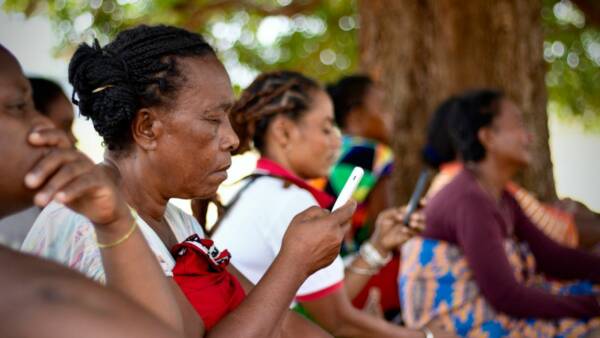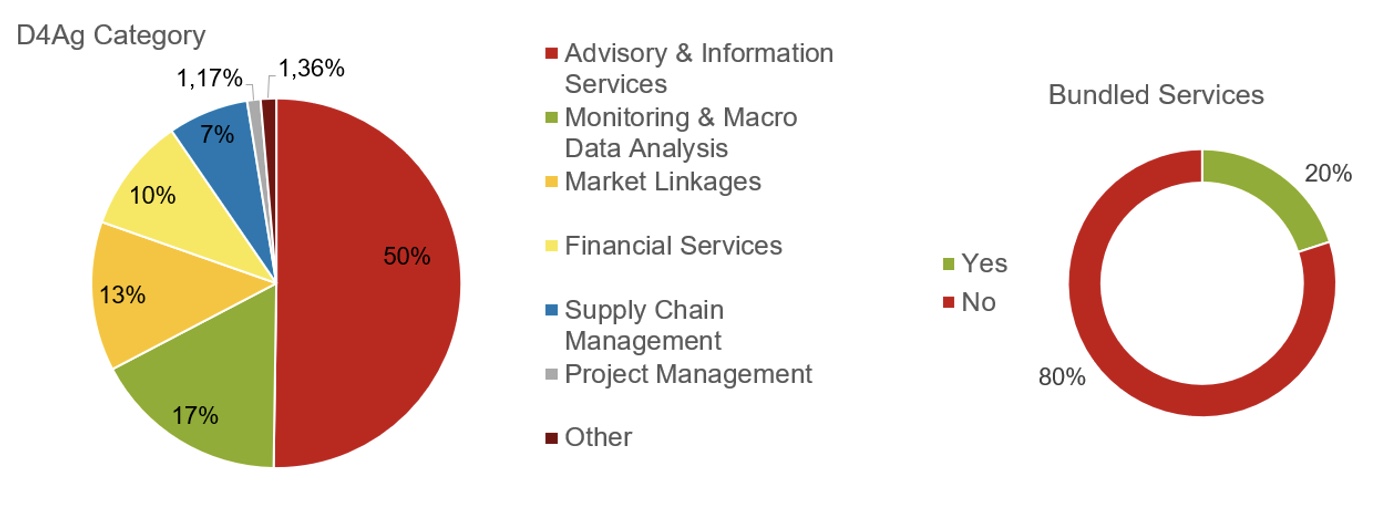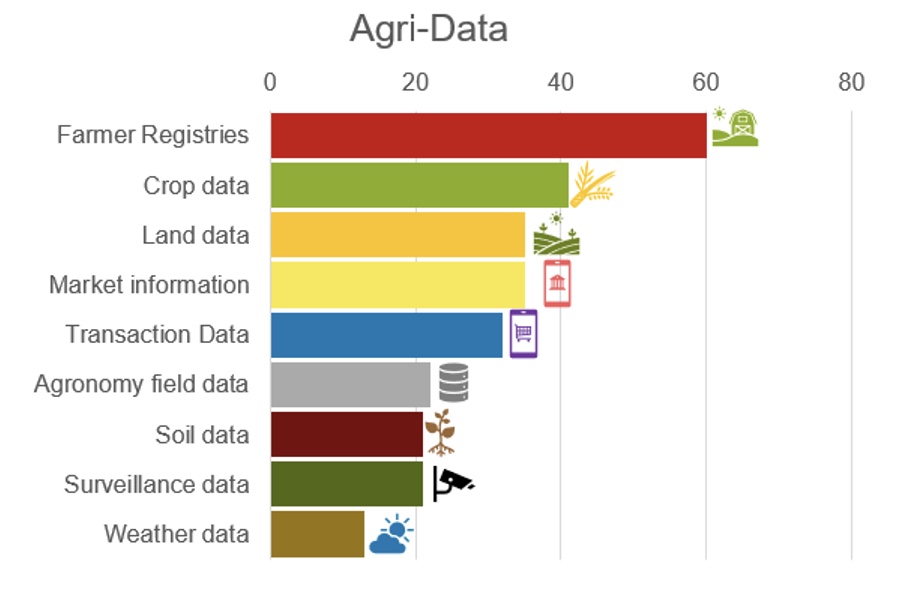Stocktaking of Digital Transformation in Agri-Food-Systems: Insights from the D4Ag Portfolio
The latest trends and interventions shaping the digital revolution in our agriculture and food systems

The Added Value of This Article
Hover over to have a look!Value add for readers
- Become familiar with the GIZ Digitalization for Agriculture (D4Ag) Portfolio, and be updated on first results after the most recent survey
- Understand the trends and emerging areas of focus within the D4Ag Portfolio, enabling practitioners to stay ahead of the curve and align their efforts with the evolving landscape of the digital transformation
- Learn about the challenges and opportunities associated with scaling digital solutions in international development, providing practitioners with valuable lessons and guidance for successful implementation and impact
Photo: © Farm Radio International
There is a widespread consensus that digital technologies will play a progressively important role in transforming the agricultural and food systems. This transformation is a priority on the political agenda of Germany’s Federal Ministry for Economic Cooperation and Development (BMZ) and many of its partner countries, reflecting a global recognition.
Leveraging digital tools to further support and drive this transformation can effectively address challenges such as global food and nutrition insecurity, climate change, youth unemployment, and economic crises.
Digitalized agricultural systems possess great potential not only to support this change but also to make it sustainable and inclusive simultaneously.
Understanding the D4Ag Portfolio and Its Growth
The Sector Project Agriculture is commissioned by BMZ to run a portfolio analysis, covering digital interventions within its Special Initiative Transformation of Agricultural and Food Systems. With the help of 19 projects, which have been working on digital interventions in their respective project contexts, the Digitalization for Agriculture (D4Ag) Portfolio counts more than 400 interventions and has grown by 35 percent over the last two years.
Scope and Reach — The Survey
Digital interventions in the survey include:
- Products and services that utilize digital tools, digital channels, or digitally-enabled data analytics, such as machine learning
- Specifically to deliver information, advice, farming input linkages, market access, and logistical support as well as financial services, and decision-making tools
- These interventions go directly to smallholder farmers or to other intermediaries of agricultural value chains, including extension agents, agro-dealers, agribusinesses, financial service providers and policymakers
After the latest survey (beginning of 2023), it is safe to conclude a trend of about 85 to 95 new interventions that are added to the portfolio each year.
Digital interventions within the Special Initiative Transformation of Agricultural and Food Systems are currently active across 52 countries. Sub-Saharan Africa accounts for 16 of the top 20 countries, which is in line with the programmatic focus of the Special Initiative.
Kenya, with one of the most progressive and well-known digital ecosystems in Africa, tops the list of countries with a current total of 75 interventions. Keeping Germany aside on rank two with 70 registered interventions because of GIZ’s head office being located there, Ethiopia (57) and Madagascar (52) follow right after. The three top countries, excluding Germany, represent 38 percent of all the interventions in the Digitalization for Agriculture Portfolio.
A clear trend can be seen in the development of prevalently national-level interventions which account for 67 percent of the inventory – less than 20 percent are interventions used in multiple countries. This suggests that GIZ D4Ag interventions are developed around country-specific needs and contexts compared to solutions that are designed to be implemented in multiple regions.
Building on the categorization of five use cases for digital interventions, based on the “Digitalization of African Agriculture Report” (2019), all categories are covered in the Digitalization for Agriculture Portfolio. Within the inventory digital advisory services still represent the largest D4Ag category, accounting for half of all interventions. Digital advisory services range over very diverse areas and aim to increase the frequency of points of contact with rural people and overcome some of the inherently structural issues with the dissemination of innovation and knowledge (see for example AccessAgriculture.org or FarmRadio.org).
Nevertheless, it should be noted that there is still a consensus that digital advisory services are not yet there to fully replace extension agents with face-to-face interactions but will make their contribution to support the knowledge-intensive transformation within the agri-food systems. There is also a perception that worldwide too many niche solutions exist and that there is a need to bring them together. Within this portfolio, only 20 percent of the digital interventions were categorized as bundled services, meaning most interventions offered only a single use-case in one intervention.

GIZ D4Ag Main Categories & Bundled Services (own illustration)
However, there is evidence suggesting a diversification in new registrations, particularly in financial services, market linkages, and supply chain management, which account for 43 percent of new registrations compared to 30 percent of the overall inventory. This trend aligns with the evolving international context of supply chain due diligence and the increasing demand for traceability. It demonstrates how digitalization can effectively enhance and adapt existing systems for improved outcomes.
Unsurprisingly, the areas which are least covered by the interventions are general infrastructure support and developments in the field of hardware and Internet of Things (IoT) equipment such as smart sensors or automated irrigation control systems. In line with the general GIZ activities, there is a strong preference towards Digitalization for Agriculture services, development of human capital and general D4Ag ecosystem support over the physical aspects of D4Ag.
Sensors, drones or weather stations are important to develop data resources and provide the foundations of analytics in agriculture in the future. Such data (see Figure 2) play an immensely important role in a sustainable agri-food transformation. Yet the accessibility to agricultural data is often very limited and in certain contexts also shows incomplete availability. Working towards better accessibility while filling the data gaps that still exist is crucial and needs to be done in an open, interoperable and user-friendly approach.

Agricultural Data examples collected by GIZ interventions (own illustration)
The recognized potential of digitalization to transform agricultural markets in Africa and around the world and the interest in agricultural data have led to significant investments in the market-oriented development of digital tools and applications. However, the progress made so far is often limited to pilot applications, which frequently fail to interact, be scaled up and developed into fully-fledged digital solutions in support of the digital transformation of our agri-food systems.
Only 16 percent are implemented in close coordination with the public sector where the service will be handed over and financed by public resources. A sustainable outcome in this scenario is the successful transfer of responsibility to a partner and the continuation and growth of the service. To realize the full potential of digital innovations in Africa, further development of these solutions and more nuanced evidence from both successful and unsuccessful scaling efforts are needed – also within the GIZ D4Ag Portfolio!
We would like to thank all colleagues who have contributed to this D4Ag Survey over recent years. We hope to publish more articles in the future to increase our knowledge-sharing, and to disseminate more results and trends from the Digital for Agriculture Portfolio.
Methodology used
The analysis is based on a set of questions that the Sector Project Agriculture sends (bi-)annually to the participating projects. The survey is created through the platform “KoboToolbox”, which is an intuitive easy-to-use software that helps to collect, analyze, and manage data for surveys, monitoring, evaluation, and research.
Authors
- Diana Diekjürgen, Advisor Sector Project Agriculture and member of the Digital Transformation Working Group.
- Carla Henzler, Junior Advisor Sector Project Agriculture
Both work on digitalization and sustainable agri-food systems.

